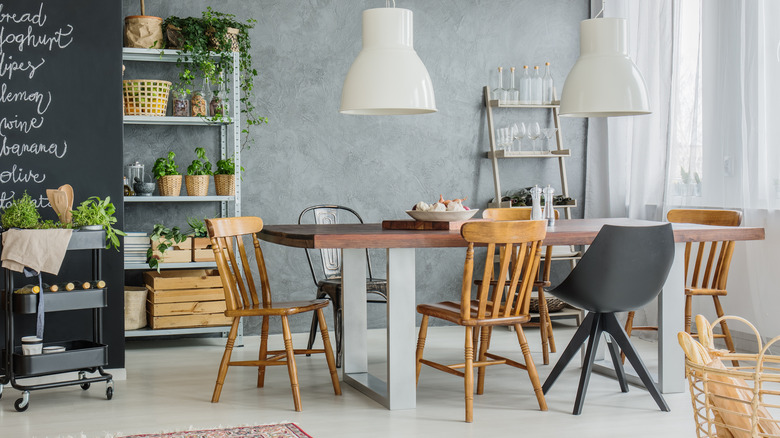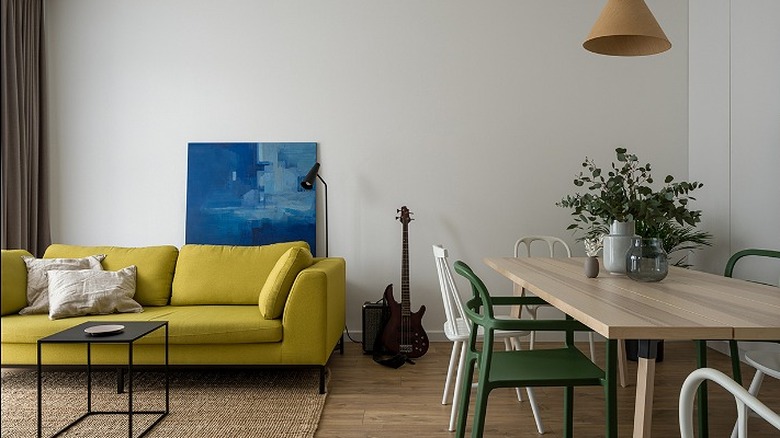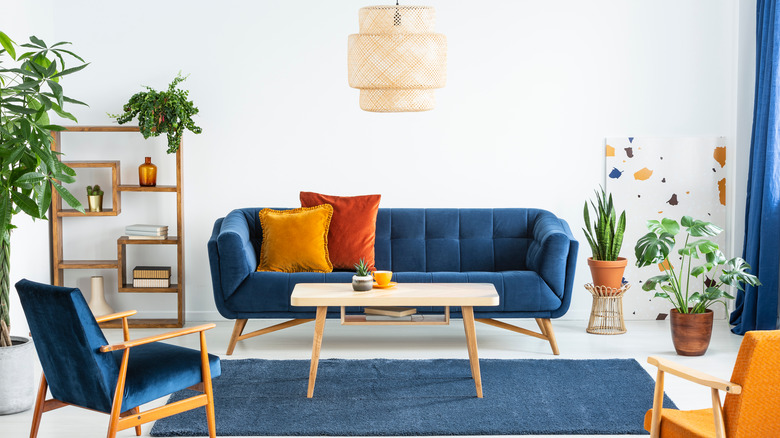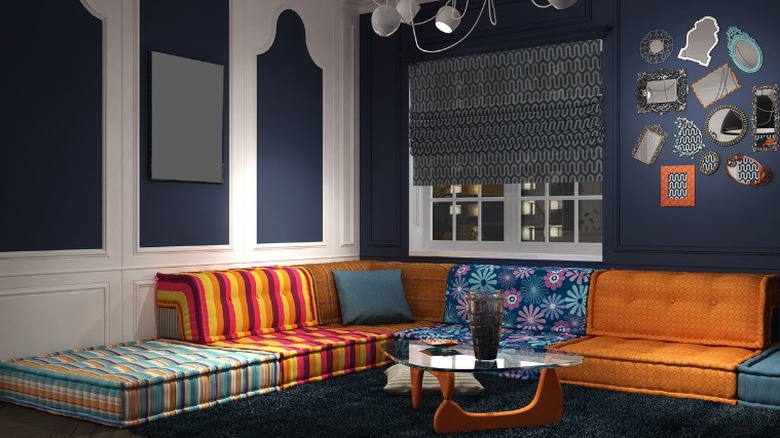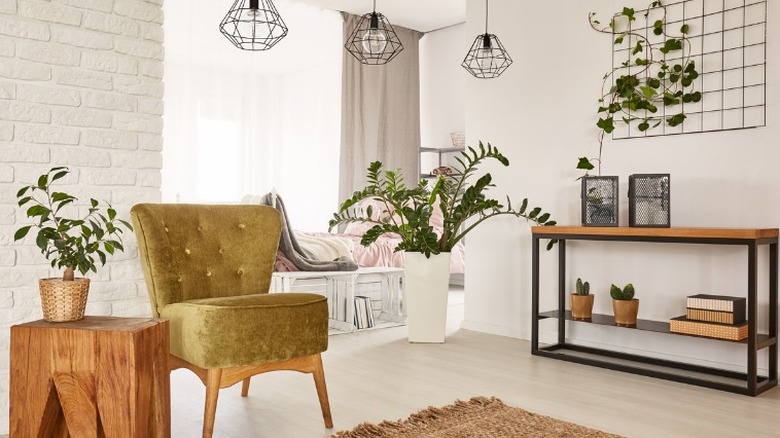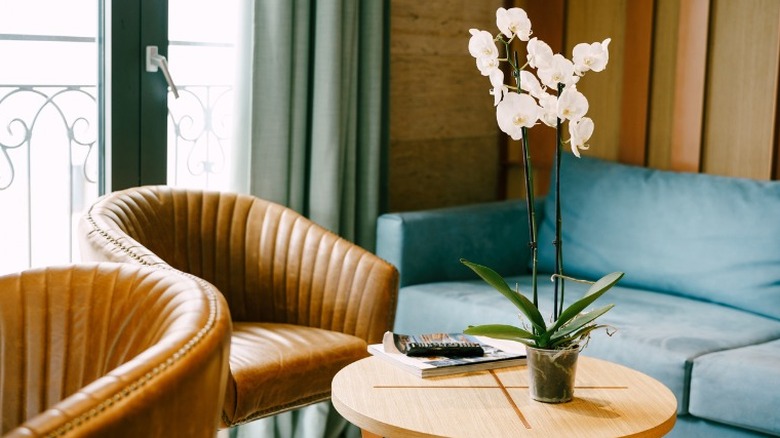5 Tips For Decorating With Mismatched Furniture
Whether in fashion or interior design, not all things need to match. Exciting, yet a little scary, mismatching your furniture in a space presents a lively and eclectic expression of you. Whether it's within the home or office, combining various pieces offers endless potential for a fresh, coordinated look. But how do you decorate with mismatched furniture? Customary approaches are to establish a theme to keep everything balanced. Instead of placing things at random, the ultimate key is to harmonize your larger pieces with your accents and so forth (via Hey There, Home).
Additionally, too much furniture will appear cluttered, and too little can seem stark. Explore symmetry and structure through common characteristics like colors and patterns, including various eras, styles, and textures. Depending on your style, you might utilize combinations of neutrals for a bohemian, coastal, or modern farmhouse appeal or mix up vibrant colors to initiate a more maximalist approach, including mid-century, eclectic, or retro.
You might also play with the same color or palette while displaying it in a variety of shades. Places that might most benefit from this are the living and dining areas, but also bedrooms. For example, a wooden farmhouse table is a great focal point to add various colors or materials to the chairs surrounding it, like the one pictured above. However you plan to decorate with furniture, the goal is to reflect on personal interest while staying centered. Keep reading to discover various ways to decorate your space with versatile, mismatched furniture.
1. Establish an era
Identify your style. There are various methods to consider within interior design, as many stem from different time periods. Modern styles may encapsulate anything popular and in-trend within the last several years, like modern farmhouses, but others may like art deco, art nouveau, Bauhaus, industrial, mid-century modern, and postmodern styles (via Kardiel). Whether you choose one time or fashion, or a combination of more than one, define what they have in common. You can integrate color and shape within any design, although some of the more vintage eras may support a vividly eclectic approach. With patterns and prints, you can display them within the same palette but in various sizes, from small to large.
Don't forget to always aim for balance. This might be achieved with similar colors, tones, and lines presented. When situating your furniture, keep similar pieces together to complement another area of interest while creating a cohesive aesthetic. Here pictured, is an open living/dining space with a blend of contemporary and rustic with a bit of boho. The relaxed farmhouse area, filled with various dining chairs, juxtaposes the cubic accent table and vibrant yellow couch with its modern rustic appearance.
2. Play with color
Approach color with creativity. If you desire imaginative combinations, you might look to the color wheel for ideas or draw upon inspiration from your interests, including keepsakes, artwork, and other décors. Most importantly, start with a significant piece of furniture like a couch, armchair, or table. Leading with your chosen pieces will direct where the vibe will ultimately go. Yellows, blues, and greens mingle well with browns and beiges, including black and white. Going further, pinks, oranges, and reds may also complement these already-established colors while blending with other neutrals. Combine rich blues with yellow, orange, brown, tan, cream, and white, as seen pictured above in the mid-century modern design.
You might also choose a specific hue and accentuate it through a monochromatic scheme. Within this method, you may incorporate a chosen color's elements through a base, along with its tone, shade, and tint (via Carpet One). Combine and conquer! Blue and green will be tranquil and soothing, pink is pleasant and feminine, while yellow and orange are delightful and warm. Also, you can keep it simple with neutrals through natural elements like wood and metal for an industrial look; whether light or dark, showcasing various shades of one color will set a tone.
3. A bold statement
If you don't know where to start, pick a distinguishable element to be the focal point. Whether it's big, bright, or inviting, family and friends will gravitate toward that statement piece. Typical focal points might include a television or fireplace, yet when it comes to furniture, a large couch will welcome guests to come in and stay a while, as well as a large congregational-style table or bar. The image above features a colorful and cozy L-shaped couch low to the floor amidst a Moroccan-style lounge area. According to Star Furniture, mixing several bold accent chairs can also provide a centralized focus. Like a perfect cocktail, if you have all the ingredients, don't be afraid to mix it up.
You can incorporate various kinds of furniture, from tufted couches to vintage lounge chairs, while finding connections through color, texture, and form. There are various mid-century chair options like egg, tulip, or swan, which would mingle nicely with diamond or wire pieces. You might intermingle leather, wood, or metal pieces, including brick, for an industrial farmhouse vibe. You could also blend various dining and/or entertaining armchairs in the same color but with a different style or material like wood or metal and vice versa.
4. Symmetry and silhouettes
A way to achieve scale and structure is to incorporate pieces that are approximately the same height, especially when it comes to mismatched furniture. You can fill a dining room table with all types of chairs while maintaining the same height and proportion. Within a living room area, situate armchairs, sofas, loveseats, or other pieces in a way that supports the regular flow of traffic within the space as well (via Interiors Place). Mismatched furniture has the potential to be simply accessible with a variety of layout options.
The shape of the furnishing is also something to showcase within your scheme. Where some things are the same, other places may vary. You might include pieces with similar lines and figures in one area and a different design style featured in another. Whether it's retro or art nouveau, combine an asymmetrical sofa with comparable pieces.
The space pictured above appears simple and conservative yet eclectic in style. With straight, mid-century lines presented in both accent and console tables for a modern vintage appeal, the elements are combined with a green tufted accent chair for a splash of old-fashioned elegance. Additionally, there's a modern farmhouse/boho feel as well from the white brick accent wall, dark cage pendant lights, green plants, and neutral colors all around.
5. Upholstered furniture
Another way to establish a mismatch in your furniture is through upholstered pieces. You may find distinctive furnishings like cushioned chairs, armchairs, sofas, benches, and ottomans with endless color and pattern options. Whether traditional or modern, there are various patterns and designs to coordinate within your theme while establishing a common bond through color or form. For example, for solid-colored fabrics, you might contrast the hue with other complementary shades like blue with yellow or orange, pink with brown or black, or purple with white or gray. Sometimes, a solid fabric piece may be featured within a patterned one that showcases a similar shade.
The texture is also a great route to differentiate your furniture, whether smooth or rough. From cotton and leather to velvet and silk, there are numerous ways to bring things together. For example, for comfort mixed with a little style, you might pair an upholstered couch with a leather sofa that's similar in scale (via Scout & Nimble). Seen above are two vintage brown leather armchairs that contrast nicely against a more contemporary blue couch while displaying about the same height. The small round tan accent table adds a lighter touch to complete the scene.
